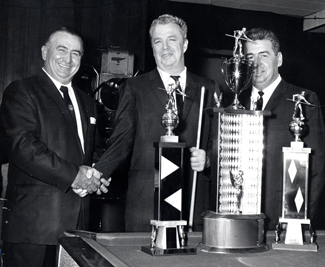|
|
Current Issue
Previous Page Page 4
Crossroads: The Legacy of Johnston City

|
| The Janscos handed plenty of hardware to Lassiter (center) over the years. |
George Jansco, a former minor-league baseball player and bookmaker, was just 46 years old during that first tournament. His brother Paulie, who was said to be more excitable and have less sense than George, was a few years younger. They grew their tournament each year, starting with 14 players, then going to 50, then to more than 80. They constructed a new building in 1964, a 4,000-square foot concrete structure with a sunken floor. It cost more than $60,000. Later they expanded to Las Vegas, where they sponsored the Stardust tournaments, then the richest in pool. The Janscos did big things for pool and it's high time that both were inducted into the BCA Hall of Fame. No matter what you think of their legacy, it's undeniable that their tournaments marked a new day for our sport.
Consider, for example, that it was the Janscos' tournaments that first elevated one-pocket from a "hustler's gimmick" (as Mosconi once called it) into a bona fide tournament game. Although the Janscos eventually added other games to the tournaments, they especially nurtured one-pocket and created what was, in effect, the national one-pocket championship. In this way, the Johnston City events of the 1960s were much like the Derby City Classic events of today.
The Jansco tournaments also bridged the old straight-pool era to that of modern 9-ball. George and Paulie Jansco were always disdainful of straight pool, considering it the most boring of all pool games. They became the first important tournament promoters to heretically condemn that game. The Jancos included straight pool in their post-1961 Johnston City events, but only grudgingly so, and Paulie dropped it completely from later Stardust events. Straight pool, once considered the game of champions, has nearly died off since then.
The Janscos also sponsored some of the earliest high-profile tournaments to feature 9-ball. This, too, had an impact. Before the Janscos' tournaments, the only pool events that ever made it to TV were 14.1 contests. Nowadays it's 9-ball and only 9-ball. The Janscos even changed the 9-ball rules to better comport with the needs of TV. The one foul ball-in-hand rule? That's all George and Paulie Jansco. Of course, I'm not arguing that these are necessarily positive developments; I'm just saying they're important ones. Nor am I blaming the Janscos completely for straight pool's demise, although I do think it's likely that their tournaments helped turn attention away from the game.
And as I noted earlier, the Jansco events were the first significant tournaments to exalt pool gamblers and to promote their way of life. But Steve Booth, founder of One-Pocket.org and the One-Pocket Hall of Fame, makes another more subtle distinction. He believes the Johnston City tournaments were not only about gambling, but rather the first to marry both sides of pool: that of the respectable tournament players and the darker side. "This is why they were so significant," he said. "If you think about pool, it always had two sides, two faces: it's had the clean image that the BCA likes to promote, and it had the gambling and the hustling image. They're both real, and they both have their own following. What was so significant about Johnston City was that George Jansco brought those two elements together. They co-existed. They thrived. And they attracted huge media attention."
Paulie took over in 1969, after George Jansco was struck dead by a massive stroke. Poor George was just 53 years old. Then came 1972, the bad year. There was a fatal shooting at the Show Bar on Oct. 8, and a major gambling bust 18 days later, on Oct. 26. Scores of federal agents swooped down a little past midnight, arresting what hustlers they could and scattering the rest. Several handguns were found stashed in the bleachers and a wastebasket. Hubert Cokes avoided jail time by paying a $500 cash bond on the spot. Paulie was issued a warrant for holding bets.
Minnesota Fats was dismissive of the entire affair. "I can't see why they are making such a big stink out of it," he reportedly told a grand jury shortly afterward. "[This raid] is the most ridiculous thing you ever heard of. There's gambling everywhere on earth, you understand. Those kinds of things happen everyday."
But the damage was done. The raid, the shooting, the temporary suspension of Paulie's liquor license - all of it effectively killed the Johnston City Hustlers Jamborees. The tournament in 1972 would be the last, the end of an era. The hustlers left Johnston City, never to return.
But for a short while, it was beautiful to behold.
"And we got to see it firsthand," said Karen Fox, the widow of the writer. "You know, television has a way of sterilizing stuff like that. ... But what we saw was pure, and raw, and real. There was a moment in time, a freeze-frame, that we had that privilege to see. Those guys were incredible characters. And oh my God, it was awesome."
R.A. Dyer is the author of "Hustler Days" and "The Hustler & The Champ." You can read his blog at poolhistory.com.
Previous Page Page 4
Top |
|





